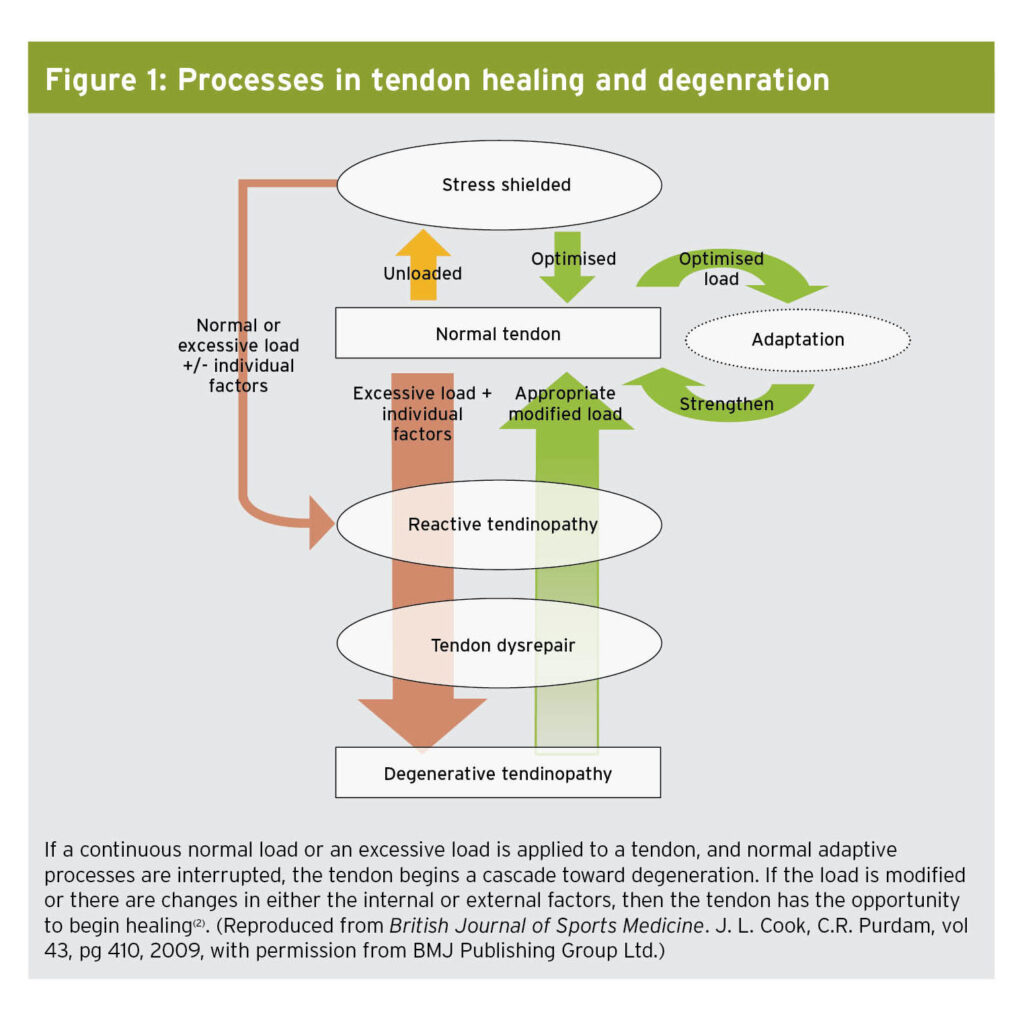An Abstract on Recent Studies
“The intrinsic pathogenetic mechanisms of tendinopathies are largely unknown and whether inflammation or degeneration has the prominent role is still a matter of debate. Assuming that there is a continuum from physiology to pathology, overuse may be considered as the initial disease factor; in this context, micro-ruptures of tendon fibers occur and several molecules are expressed, some of which promote the healing process, while others, including inflammatory cytokines, act as disease mediators. Neural in-growth that accompanies the neovessels explains the occurrence of pain and triggers neurogenic-mediated inflammation. It is conceivable that inflammation and degeneration are not mutually exclusive, but work together in the pathogenesis of tendinopathies.”1
“Healing in healthy tendons is divided into three stages:
- The initial response after strain is inflammation, which provides clotting to ruptured vessels within the tendon, and consumes the tissue that is no longer viable.
- In the proliferative and repair stage that follows, fibroblasts and tenocytes rush to the wound site, multiply, and rebuild the structure of the tendon.
- The remodelling phase begins one to two months after injury, when the collagen fibres align in the direction of stress along the tendon. Through this process, tendons adapt and grow in thickness and length.
Historically, symptomatic tendons that failed to heal were assumed stuck in a cycle of inflammation and the condition was labelled tendonitis. Subsequent research has found evidence of degeneration within symptomatic tendons, and the inflammatory theory was subsequently discarded in favour of the term ‘tendinosis’. More recent work suggests that both inflammation and degeneration exist in failed tendon healing, called tendinopathy.”2
“Although tendons undergo healing when injured, the healed tendons never regain the same mechanical properties as before. This is in large part due to the release of a group of chemicals called matrix metalloproteinases (MMPs). This happens during the remodelling of the healing tendon. Certain MMPs are capable of degrading collagen fibrils (the main components of a tendon responsible for its tensile strength). When collagen fibrils become degraded, the tendon loses some of its tensile strength, and becomes weaker.

Hence, even with normal muscle use, it may cause further damage or prevent optimal healing of the already injured weaker tendon; predisposing the tendon to a faster rate of degeneration.
Make sure you let your tendons heal. The further the extent of the injury, the tendon has to ‘travel’ a longer healing journey and less likely to make it back to its previous state. But in reality, for some, this is not a option, particularly for performance athletes whose high-volume training regime exacerbates the tendon injury but whose sports requires that they maintain the physical peak form. This cuts down on the rest that they requires.”3
Utilizing shockwave therapy provides faster healing and maximizes the opportunity for athletes to recover during gametime. “Exercise and extracorporeal shockwave therapy (ESWT) is among the most common treatments used to mediate tendon healing and regeneration. The review presents the current understanding of mechanisms of action of ESWT and exercise in isolation and briefly synthesises evidence of their effectiveness for various tendinopathies. The central purpose of the review is to synthesize research findings investigating the combination of ESWT and exercise for five common tendinopathies (plantar heel pain, rotator cuff, lateral elbow, Achilles, and patellar tendinopathy) and provide recommendations on clinical applicability.” (Read more of this study HERE)
“Shockwave therapy significantly reduced the pain that accompanies tendinopathies and improves functionality and quality of life. It might be first choice because of its effectiveness and safety.”4
- https://arthritis-research.biomedcentral.com/articles/10.1186/ar2723
- https://www.sportsinjurybulletin.com/tendinopathy-inflammation-degeneration-and-treatment/
- https://www.coreconcepts.com.sg/article/tendon-disorders-inflammation-and-degeneration/
- https://www.ncbi.nlm.nih.gov/pmc/articles/PMC6029898/
